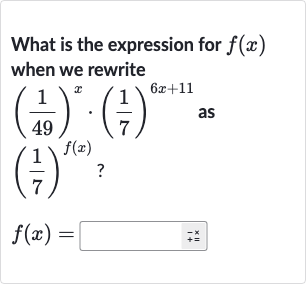AI tutor
Full solution
Q. What is the expression for when we rewrite as ?
- Rewriting base : We need to express the given function in terms of a single base to match the form . Let's start by rewriting the base in terms of , since is squared.
- Simplifying base : The base can be written as . Therefore, can be rewritten as . This simplifies to because when you raise a power to a power, you multiply the exponents.
- Combining the bases: Now we have . Since the bases are the same, we can add the exponents to combine them into a single expression.
- Simplifying the exponents: Adding the exponents, we get . Simplifying the exponents, we have .
- Determining : Now that we have the expression in the form , we can see that "something" is our . Therefore, .
More problems from Compare linear and exponential growth
QuestionGet tutor help
QuestionGet tutor help
QuestionGet tutor help
QuestionGet tutor help
QuestionGet tutor help
QuestionGet tutor help
QuestionGet tutor help

